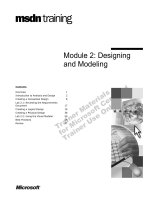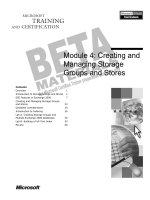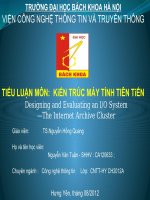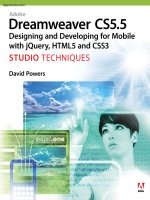usb mass storage designing and programming devices and embedded hosts
Bạn đang xem bản rút gọn của tài liệu. Xem và tải ngay bản đầy đủ của tài liệu tại đây (3.21 MB, 304 trang )
USB Mass Storage
Designing and Programming
Devices and Embedded Hosts
Jan Axelson
Lakeview Research LLC
Madison, WI
USB Mass Storage: Designing and Programming Devices and Embedded Hosts
by Jan Axelson
Copyright 2006 by Janet L. Axelson
All rights reserved. No part of the contents of this book, except the program code, may be
reproduced or transmitted in any form or by any means without the written permission of
the publisher. The program code may be stored and executed in a computer system and may
be incorporated into computer programs developed by the reader.
The information, computer programs, schematic diagrams, documentation, and other
material in this book are provided “as is,” without warranty of any kind, expressed or
implied, including without limitation any warranty concerning the accuracy, adequacy, or
completeness of the material or the results obtained from using the material. Neither the
publisher nor the author shall be responsible for any claims attributable to errors, omissions,
or other inaccuracies in the material in this book. In no event shall the publisher or author
be liable for direct, indirect, special, incidental, or consequential damages in connection
with, or arising out of, the construction, performance, or other use of the materials con-
tained herein.
Many of the products and company names mentioned herein are the trademarks of their
respective holders. MPLAB, PICDEM, PICmicro, and PICtail are registered trademarks of
Microchip Technology Inc. in the U.S.A. and other countries.
Certain materials contained herein are reprinted with the permission of Microchip Technol-
ogy Incorporated. No further reprints or reproductions may be made of said materials with-
out Microchip Technology Inc.’s prior written consent.
Published by Lakeview Research LLC, 5310 Chinook Ln., Madison WI 53704
On the web at www.Lvr.com
Distributed by Independent Publishers Group (www.ipgbook.com).
14 13 12 11 10 9 8 7 6 5 4 3 2 1
Printed and bound in the United States of America
ISBN13 978-1-931448-05-5
ISBN10 1-931448-05-1
iii
Contents
Acknowledgements xi
Introduction xiii
1 Mass Storage Basics 1
When to Use a Storage Device 1
Benefits 2
Other Considerations 3
Requirements 4
Devices 4
Embedded Hosts 5
Selecting a Media Type 7
Drive Mechanisms 8
Addressing Methods 10
Reading and Writing Considerations 10
Removable Media and Devices 12
Hardware Interfaces 12
Hard Drives 13
Technology 13
Interfaces 13
Flash Memory 13
Technology 14
Options for Flash Memory 15
MultiMediaCard 16
SD Memory Card 20
CompactFlash 22
Contents
iv
2 Supporting USB 25
The Interface in Brief 26
Hosts and Devices 26
Host Responsibilities 27
Device Responsibilities 29
Bus Speeds 31
Endpoints 31
Transfer Types 32
Transactions 32
The Data Toggle 33
Descriptors 34
Mass Storage Requirements 34
Choosing a Device Controller 37
Controllers with Support for Flash Memory 37
Controllers with support for ATA/ATAPI 38
Firmware Options 38
Microchip PIC18F4550 39
Architecture 39
Firmware Support 39
The USB Controller 39
3 The USB Mass Storage Class 45
Requirements 45
Specifications 45
Logical Block Addressing 46
Mass Storage Requests 46
Descriptors 46
Device Descriptor 47
Configuration Descriptor 49
Interface Descriptor 51
Endpoint Descriptors 53
String Descriptors 54
Contents
v
Responding to Commands 55
The Command Block Wrapper 56
The Command Status Wrapper 60
Managing Communications on the Bulk Endpoints 62
More about STALL 72
Thirteen Cases for Any Situation 73
PC Support 76
Windows 76
Linux 77
4 Accessing Flash Memory Cards 79
The Interface 79
Signals and Power 80
Example Circuit 80
Host Programming 83
Configuring 83
Hardware Ports 85
Firmware-controlled Ports 86
Transferring Data 86
Default States 86
SPI on the PIC18F4550 86
Configuring the Port 88
Writing a Byte 89
Reading a Byte 91
5 MultiMediaCard Protocol 93
Command and Response Formats 93
Commands 94
Response Types 94
Token Formats 98
The Commands 99
Classes 99
Commands Used by Mass-storage Devices 100
Registers 101
Contents
vi
Sending Commands 101
Timing Considerations 102
Commands with No Data Transfer 105
Commands that Read Data from the Storage Media 105
Commands that Write Data to the Storage Media 106
Application Example 107
Detecting and Selecting a Card 107
Sending a Command 109
Reading a Sector 118
Writing a Sector 120
Initializing Communications 123
6 SCSI Commands 131
About the Commands 131
Specifications 131
Which Commands to Implement? 132
Sense Data 135
Fixed-format Sense Data 137
Setting Default Values 138
Primary Commands 139
INQUIRY 139
MODE SELECT 143
MODE SENSE 143
PREVENT ALLOW MEDIUM REMOVAL 145
REPORT LUNS 146
REQUEST SENSE 146
SEND DIAGNOSTIC 147
TEST UNIT READY 147
Contents
vii
Block Commands 148
FORMAT UNIT 148
READ 149
READ CAPACITY 152
START STOP UNIT 154
SYNCHRONIZE CACHE 154
VERIFY 155
WRITE 155
Multimedia Commands 159
READ FORMAT CAPACITIES 159
READ TOC/PMA/ATIP 159
Handling Commands and Events 160
Decoding Commands 160
The UNIT ATTENTION Condition 161
Informing the Host about Media Changes 162
Reset Behavior 163
7 Media Structure 165
A Look Inside 165
Components of Formatted Media 166
Drives without an MBR Sector 168
Byte Order 168
The Master Boot Record Sector 168
Executable Code 169
The Partition Table 169
Extended Partitions 170
The Boot Signature 172
8 FAT File Systems 175
Inside a FAT16 Volume 175
Reserved Region 176
File Allocation Table Region 179
Root Directory Region 180
File and Directory Data Region 180
Contents
viii
Inside a FAT32 Volume 181
Reserved Region 181
File Allocation Table Region 184
File and Directory Data Region 185
Selecting a File System 185
Cluster Sizes 185
A Hardware Solution 186
The File Allocation Table 188
The First Two Entries 188
Data Clusters 188
Accessing the FAT 190
Volume Information 190
File Information 191
Obtaining a Cluster’s Logical Block Address 192
Reading from the FAT 192
Writing to the FAT 194
Finding a File’s Next Cluster 195
Performing Sequential Reads 197
Finding an Empty Cluster 198
9 Directories 201
The Contents of an Entry 201
File Entries 202
Directory Entries 205
The Volume Label Entry 206
Subdirectory Entries 207
Handling Long File Names 207
LFN Entries 207
The Checksum 209
Creating a Short File Name 210
Contents
ix
Using Directories 211
Storing an Entry 211
Reading an Entry 212
Getting the Main Entry 217
Updating an Entry 219
Updating the Time and Date 220
10 File Operations 223
Cluster Operations 224
Erasing a Cluster 224
Reserving an Available Cluster 225
Allocating a File’s First Cluster 226
Allocating Additional Clusters 226
Managing Files 228
Obtaining File Information 228
Finding a File 231
Creating a Directory Entry 234
Finding an Available Entry 235
Creating a File 238
Deleting a File 239
Opening a File 243
Reading from a File 246
Tasks 246
Performing a Read Operation 247
Writing to a File 250
Tasks 250
Performing a Write Operation 251
Closing a File 257
Contents
x
11 Embedded Hosts 259
Inside an Embedded Host 259
OTG Devices and Conventional Hosts 260
General Host Functions 260
Mass Storage Functions 261
Handling Non-compliant Devices 263
Host Options 266
Cypress EZ-HOST 266
Host Software 267
A Mass-storage Host Module 267
Index 271
xi
Acknowledgements
Many people helped in the development and writing of this book.
My technical reviewers helped to keep me on track, pointed out errors, sug-
gested additions to improve the book, and answered many questions. (With
that said, any errors that remain are my fault alone.) Thanks to Paul E. Berg
of MCCI and USB-IF Device Working Group Chair for encouragement
and help in finding reviewers. Thanks also to John Hyde of USB Design by
Example, to Pat LaVarre, to Hiromichi Oribe of Hagiwara Sys-Com Co.,
Ltd., to Rawin Rojvanit and Gurinder Singh of Microchip Technology, Inc.,
and to Alan Stern of the Rowland Institute at Harvard.
For their help in obtaining products used in the writing of the book, thanks
to Laurent Guinnard of Ellisys, Gus Issa of GHI Electronics, and Alan
Lowne of Saelig Co. Inc.
This page intentionally left blank
xiii
Introduction
A mass-storage device can provide access to data for just about any purpose.
Every time you load an application or save a file on a PC, you’re using a
mass-storage device. A computer’s hard drive is a mass-storage device, as are
flash, CD, and DVD drives. Devices with dedicated functions—data log-
gers, robots, and other embedded systems—can use mass storage as well.
Every mass-storage device contains a microcontroller, microprocessor, or
other intelligent hardware that knows how to access the contents of the stor-
age media.
A USB device controller enables a mass-storage device to share its data with
other computers. For example, a data logger can collect data in the field and
then connect to a PC, where an application reads the data from the logger’s
storage media. Or a robot can attach to a PC to receive a file containing con-
figuration data to use in robotic tasks.
Flash-memory cards provide convenient storage for many small systems.
Other systems function as USB hosts that can access files in off-the-shelf
USB flash drives and hard drives.
Introduction
xiv
If you’re involved with designing or programming devices that incorporate a
USB mass-storage device or host interface, this book will help you get your
projects up and running. You’ll also find the book useful if you’re designing
or programming devices that use flash-memory cards for data storage,
whether or not the devices have USB interfaces.
Interfaces, Protocols, and Technologies
Designing and programming a USB mass-storage device or embedded USB
host involves a variety of interfaces, protocols, and structures.
Every USB mass-storage device must support two interfaces:
• A USB device interface to enable the device to communicate with a PC
or other USB host.
• An interface between the device’s microcontroller or other CPU and the
storage media. Flash-memory cards typically use the Serial Peripheral
Interface (SPI), MultiMediaCard bus, SD-Card bus, or a bus derived
from the ATA interface or PC-Card bus. Hard drives typically use the
ATA parallel interface.
A USB mass-storage device must implement these protocols and structures:
• Generic USB protocol. Every USB device must respond to requests sent
by the USB host and other events on the bus.
• USB mass-storage protocol. Every USB mass-storage device must detect
and respond to requests that are specific to the USB mass-storage class.
• SCSI commands. USB hosts access mass-storage devices via commands
originally developed for devices that use the Small Computer Systems
Interface (SCSI).
• Media-specific protocol. The storage media’s controller typically supports
a command set for accessing the media’s contents. Many flash-memory
cards use the MultiMediaCard protocol or the SD Card protocol. Hard
drives use the ATA protocol.
Reading and writing data to a mass-storage device also involves understand-
ing logical structures in the media:
• Media structure. Program code accesses the storage area in drives as a
series of logical blocks, or sectors. Dedicated areas in the media store
Introduction
xv
information about the logical blocks and other logical structures in the
media.
• File system. If the device firmware reads or writes to files on its own,
rather than via a USB host, the device must implement a file system such
as FAT16 or FAT32.
This book shows how to put all of these interfaces, protocols, and structures
to work in a USB mass-storage device. The book assumes you have a basic
familiarity with microcontroller programming and interfacing. For more
about USB, I recommend my book, USB Complete: Everything You Need to
Develop Custom USB Peripherals.
About the Code
This book include code examples written for the Microchip PIC18F4550
microcontroller using Microchip’s MPLAB
®
C18 C compiler. On my web-
site (www.Lvr.com) you can find links to complete mass-storage firmware
for this chip and example mass-storage firmware for other microcontrollers.
For More Information
In addition to example code, www.Lvr.com has links to specification docu-
ments, white papers, corrections and additions to this book, and other infor-
mation to help you design and program USB mass-storage devices.
I hope you find the book useful!
Jan Axelson
This page intentionally left blank
1
1
Mass Storage Basics
A mass-storage device is electronic hardware that stores information and
supports a protocol for sending and retrieving the information over a hard-
ware interface. The information can be anything that can be stored electron-
ically: executable programs, source code, documents, images, spreadsheet
numbers, database entries, data logger output, configuration data, or other
text or numeric data. Mass-storage devices typically store information in
files. A file system defines how the files are organized in the storage media.
In Windows computers, mass-storage devices appear as drives in My Com-
puter. From Windows Explorer, users can copy, move, and delete files in the
devices. Program code can access files using file-system APIs or .NET’s File
class.
When to Use a Storage Device
Implementing a mass-storage function is a solution for systems that need to
read or write moderate to large amounts of data.
Chapter 1
2
If the device has a Universal Serial Bus (USB) interface, any PC or other
USB host can access the storage media. Generic USB mass-storage devices
include the hard drives, flash drives, CD drives, and DVD drives available
from any computer-hardware store. Table 1-1 lists popular device types.
These devices have just one function: to provide storage space for the sys-
tems they connect to.
Another type of USB mass-storage device (or storage device for short) is the
special-purpose device with storage capabilities. For example, a camera can
capture images and store the images in files. A data logger can collect and
store sensor readings in files. A robotic device can receive files containing
configuration parameters. With the addition of a USB mass-storage inter-
face, any of these devices can use USB to exchange files with PCs and other
USB hosts.
Generic storage devices are readily available and inexpensive. Unless you’re
employed by a storage-device manufacturer, there isn’t much point in
designing and programming your own generic devices. But special-purpose
USB storage devices are useful in many embedded systems, including
one-of-a-kind projects and products manufactured in small quantities.
Another option for some systems is to add USB host-controller hardware
and mass-storage firmware. The embedded system can then store and read
files in off-the-shelf USB storage devices.
Benefits
Adding storage-device capabilities to a system has several benefits:
• With a USB device controller, a system can make the contents of its stor-
age media available to any PC or other USB host computer.
• File systems provide a standard way to store and access data. A PC or
other USB host can format the media in a USB storage device to use the
FAT16 or FAT32 file system. When the device is connected to a PC, the
operating system enables reading and writing to files. Users can access the
files without having to install and learn a vendor-specific application.
• Storage media is readily available. Flash-memory cards are convenient
and have enough capacity for many applications. Some cards require only
a few port pins to access. Devices that need large amounts of storage can
interface to hard drives.
Mass Storage Basics
3
Other Considerations
A storage device isn’t the solution for every application, however.
• Mass-storage firmware is complex. A USB mass-storage device must sup-
port the USB protocols required for all USB devices as well as class-spe-
cific mass-storage protocols. If the device firmware needs to create, read,
or write to files and directories on its own (not via the USB interface),
the firmware must also support a file system. For some applications, a
different USB class or a vendor-specific protocol would require less time
and expense to implement.
• USB mass-storage devices transfer data using bulk transfers. These pro-
vide the fastest transfers on an otherwise idle bus but have no guaranteed
timing or bus bandwidth. If your device needs precise timing in transfer-
ring data, the mass-storage class isn’t appropriate.
• A storage device should have one mass-storage master at a time. The mas-
ter, or mass-storage host, is the computer that reads and writes to the
storage media. Special-purpose mass-storage devices can function as mas-
ters on their own and can also permit a PC or other USB host to func-
tion as the master. If one master adds, deletes, or changes a file and the
other master isn’t aware of the changes, confusion or worse problems can
result. Devices that support two masters can have a manual or electronic
switch to enable one master at a time, or a device can use firmware proto-
cols to inform the host when the media’s contents have changed. For
some designs, another approach without this added complexity makes
more sense.
Table 1-1: Common USB mass storage devices use a variety of storage media.
Device Storage Media Local CPU Interface
to Media
Removable Media?
Hard drive Hard disk ATA No
CD drive CD ATA + ATAPI Yes
DVD drive DVD ATA + ATAPI Yes
Flash drive Flash memory Local CPU data bus No
Flash-memory-card
reader/writer
Flash memory SPI,
MultiMediaCard bus,
SD-Card bus
Yes
Chapter 1
4
Alternate approaches for USB devices that transfer generic or vendor-spe-
cific data include the human-interface device class, a device accessed via a
virtual COM port, or a generic or vendor-specific driver.
Requirements
Adding storage capabilities and a USB interface to an embedded system
requires hardware and firmware to support accessing the storage media and
communicating over the USB interface.
Devices
An embedded system that functions as a USB mass-storage device requires
the following hardware (Figure 1-1):
• A microcontroller or other CPU or intelligent hardware to manage the
embedded system’s operation.
• A USB device controller, which can be embedded in a microcontroller
chip or on a separate chip that interfaces to a CPU or microcontroller.
• A generic hard drive, flash drive, or other media that interfaces to the
device’s CPU.
Figure 1-1: A USB mass-storage device contains storage media, a media
controller, a device CPU or microcontroller, and a USB device controller, which
can be on a separate chip or embedded in a microcontroller.
Mass Storage Basics
5
In a USB mass-storage device, the hardware or firmware must perform the
following functions:
• Detect and respond to generic USB requests and other events on the bus.
• Detect and respond to USB mass-storage requests for information or
actions from the device.
• Detect and respond to SCSI commands received in USB transfers. These
industry-standard commands read and write blocks of data in the storage
media, request status information, and control device operation.
In addition, devices that create, read, or write to files and directories on their
own (not via a USB host) must implement a file system. A file is a named
collection of data. A directory structure provides an index to the files. Popu-
lar file systems for embedded systems include FAT16 and FAT32.
Two popular types of storage media for embedded systems are flash-memory
cards and hard drives. A flash-memory card contains flash-memory chips to
provide storage, a controller that manages reading and writing to the mem-
ory, and an interface to the outside world. Common types of flash-memory
cards includes the MultimediaCard (MMC), Secure Digital (SD) Card, and
CompactFlash
®
(CF
®
) card. A hard drive contains a hard disk that provides
storage, drive components to perform functions such as spinning the disk
and positioning the heads, a drive controller, and an interface to the outside
world. An embedded system that accesses flash-memory cards or hard drives
must have a microcontroller or other CPU or intelligent hardware to man-
age communications with the cards or drives.
This book focuses on block storage devices, where data is transferred in
blocks of defined sizes. USB hard drives and flash drives are block storage
devices. Other devices are stream devices, where each data transfer is a
sequence, or stream, of data that can be any length. An example of a stream
device is a modem that carries voice communications.
Embedded Hosts
An embedded system that functions as a USB host for flash or hard drives
requires the following hardware (Figure 1-2):
• A microcontroller or other CPU or intelligent hardware to manage the
embedded system’s operation.
Chapter 1
6
• A USB host controller, which can be embedded in a microcontroller chip
or on a separate chip that interfaces to the CPU, microcontroller, or
other intelligent hardware.
• A generic hard drive, flash drive, or other media connected to a USB port
on the host.
The hardware or firmware in an embedded USB mass-storage host must
provide the following functions:
• Issue USB requests and initiate other events on the bus to identify
attached devices and manage traffic and power on the bus.
• Issue USB mass-storage requests that ask for status information or specify
actions for the device to perform.
• Issue SCSI commands in USB transfers. The commands read and write
blocks of data in the storage media, request status information, and con-
trol the device operation.
• Support a file system to access files in the media.
Figure 1-2: To access generic USB mass-storage devices, an embedded
system must contain a USB host controller, which can be on a separate chip or
embedded in a microcontroller.
Mass Storage Basics
7
Selecting a Media Type
The storage media is the physical entity that holds a device’s data. In embed-
ded systems, a storage device’s media is typically separate from the system’s
program memory, which stores the code executed by the system’s CPU.
Over time, various storage technologies and form factors have come and
gone in popularity. Currently popular technologies include hard drives,
CD/DVD drives, flash-memory cards, and USB flash drives (Figure 1-3).
Other names for a USB flash drive (UFD) include USB key, pen drive,
ThumbDrive
®
, DiskOnKey
®
, and JumpDrive
®
.
The different media types vary in the hardware and circuits required to
access the media, the ability to erase and rewrite, methods of write protec-
tion, whether the media is removable from its drive, and interface options
for external CPUs.
For many devices, flash memory is a good choice for storage media.
Flash-memory cards are physically small, can store moderate amounts of
Figure 1-3: USB flash drives provide convenient storage that PCs and other
USB hosts can access.
Chapter 1
8
data, and manage the low-level protocols for accessing the memory. Some
cards require only a few port pins to access. With the addition of a USB
device controller and supporting firmware, USB hosts can access the data in
a device’s flash-memory card. Users can also remove a card from the device
and insert the card in a card reader attached to a PC or other computer.
Flash memory consumes less power than other media types. When attached
to a USB host or hub, a typical flash-memory storage device can receive all
of its power from the bus.
Hard drives are the cheapest per byte and can hold massive quantities of
data. CD and DVD drives are less common in embedded systems because
embedded applications tend to require media that is easily erased and rewrit-
ten. CD-RW, DVD-RW, and DVD+RW discs can be erased and rewritten,
but not as easily as magnetic media.
A device that contains a USB host controller and supporting firmware can
access ordinary USB flash drives and hard drives. Because a USB host must
manage the bus, USB host programming is more complex than USB device
programming. But for some applications, the ability to store data in generic
drives makes the increased complexity worthwhile.
Drive Mechanisms
Hard disks require a drive mechanism to spin the disks and position the read
and write heads (Figure 1-4). A hard drive contains a stack of platters. Each
platter has magnetic storage media arranged in concentric circles, called
tracks, on both sides. Each surface of a platter has a head positioned above
the platter’s surface. The head can read or write to the bit of data directly
opposite the head.
An area on a drive can be identified by cylinder, head, and sector. A cylinder
is a stack of tracks of the same diameter. Each surface has a head, so the head
identifies a surface on a platter. A sector is a portion of a track and contains
the smallest addressable quantity of data in the media. All sectors in a drive
have the same capacity, typically 512 bytes.
The drive mechanism spins the disks and moves the heads to requested
tracks. When a requested sector on a spinning disk passes under the head,









